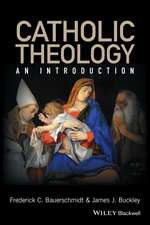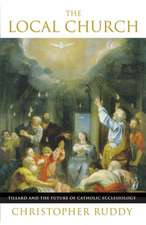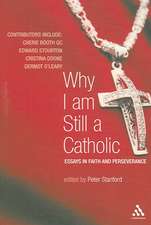Clerical Orders in the Early Middle Ages: Duties and Ordination: Variorum Collected Studies
Autor Roger E. Reynoldsen Limba Engleză Hardback – 24 dec 1999
Din seria Variorum Collected Studies
- 9%
 Preț: 938.85 lei
Preț: 938.85 lei -
 Preț: 311.41 lei
Preț: 311.41 lei -
 Preț: 351.48 lei
Preț: 351.48 lei -
 Preț: 313.38 lei
Preț: 313.38 lei -
 Preț: 386.77 lei
Preț: 386.77 lei -
 Preț: 325.68 lei
Preț: 325.68 lei -
 Preț: 396.00 lei
Preț: 396.00 lei -
 Preț: 312.75 lei
Preț: 312.75 lei - 9%
 Preț: 1041.23 lei
Preț: 1041.23 lei -
 Preț: 258.66 lei
Preț: 258.66 lei -
 Preț: 299.55 lei
Preț: 299.55 lei - 9%
 Preț: 938.08 lei
Preț: 938.08 lei -
 Preț: 343.33 lei
Preț: 343.33 lei -
 Preț: 311.18 lei
Preț: 311.18 lei - 9%
 Preț: 937.13 lei
Preț: 937.13 lei -
 Preț: 351.41 lei
Preț: 351.41 lei -
 Preț: 320.00 lei
Preț: 320.00 lei - 34%
 Preț: 764.20 lei
Preț: 764.20 lei - 36%
 Preț: 740.06 lei
Preț: 740.06 lei - 34%
 Preț: 764.20 lei
Preț: 764.20 lei - 34%
 Preț: 680.73 lei
Preț: 680.73 lei - 26%
 Preț: 247.40 lei
Preț: 247.40 lei - 34%
 Preț: 485.78 lei
Preț: 485.78 lei - 38%
 Preț: 766.91 lei
Preț: 766.91 lei - 34%
 Preț: 767.07 lei
Preț: 767.07 lei - 34%
 Preț: 764.20 lei
Preț: 764.20 lei - 34%
 Preț: 769.51 lei
Preț: 769.51 lei - 38%
 Preț: 769.85 lei
Preț: 769.85 lei - 34%
 Preț: 826.68 lei
Preț: 826.68 lei - 25%
 Preț: 225.28 lei
Preț: 225.28 lei - 25%
 Preț: 225.54 lei
Preț: 225.54 lei - 34%
 Preț: 736.38 lei
Preț: 736.38 lei - 34%
 Preț: 738.43 lei
Preț: 738.43 lei - 25%
 Preț: 226.52 lei
Preț: 226.52 lei - 33%
 Preț: 491.66 lei
Preț: 491.66 lei - 34%
 Preț: 485.78 lei
Preț: 485.78 lei - 34%
 Preț: 485.78 lei
Preț: 485.78 lei - 36%
 Preț: 739.17 lei
Preț: 739.17 lei - 38%
 Preț: 766.34 lei
Preț: 766.34 lei - 31%
 Preț: 473.94 lei
Preț: 473.94 lei - 18%
 Preț: 843.61 lei
Preț: 843.61 lei - 38%
 Preț: 774.91 lei
Preț: 774.91 lei - 38%
 Preț: 769.92 lei
Preț: 769.92 lei - 34%
 Preț: 764.20 lei
Preț: 764.20 lei - 51%
 Preț: 485.78 lei
Preț: 485.78 lei - 36%
 Preț: 488.49 lei
Preț: 488.49 lei - 34%
 Preț: 769.10 lei
Preț: 769.10 lei - 38%
 Preț: 766.99 lei
Preț: 766.99 lei - 18%
 Preț: 1019.01 lei
Preț: 1019.01 lei
Preț: 315.48 lei
Preț vechi: 410.05 lei
-23% Nou
Puncte Express: 473
Preț estimativ în valută:
60.37€ • 63.03$ • 49.96£
60.37€ • 63.03$ • 49.96£
Carte tipărită la comandă
Livrare economică 05-19 aprilie
Preluare comenzi: 021 569.72.76
Specificații
ISBN-13: 9780860788096
ISBN-10: 0860788091
Pagini: 345
Dimensiuni: 150 x 224 x 23 mm
Greutate: 0.6 kg
Ediția:1
Editura: Taylor & Francis
Colecția Routledge
Seria Variorum Collected Studies
Locul publicării:Oxford, United Kingdom
ISBN-10: 0860788091
Pagini: 345
Dimensiuni: 150 x 224 x 23 mm
Greutate: 0.6 kg
Ediția:1
Editura: Taylor & Francis
Colecția Routledge
Seria Variorum Collected Studies
Locul publicării:Oxford, United Kingdom
Cuprins
Contents: Preface; The pseudo-Hieronymian De septem ordinibus ecclesiae: notes on its origins, abridgements, and use in early medieval canonical collections; The De officiis vii graduum: its origins and early medieval development; The ’Isidorian’ Epistula ad Leudefredum: an early medieval epitome of the clerical duties; Isidore’s texts on the clerical grades in an early medieval Roman manuscript; A ninth-century treatise on the origins, office, and ordination of the bishop; A florilegium on the ecclesiastical grades in Clm 19414: testimony to ninth-century clerical instruction; An early medieval tract on the diaconate; Image and text: a Carolingian illustration of modifications in the early Roman eucharistic ordines; Marginalia on a tenth-century text on the ecclesiastical officers; Ivonian opuscula on the ecclesiastical officers; The ordination of clerics in the Middle Ages; The ritual of clerical ordination of the Sacramentarium Gelasianum saec.viii: early evidence from southern Italy; The ordination rite in medieval Spain: Hispanic, Roman, and hybrid; A south Italian ordination allocution; Addenda and corrigenda; Index; Index of manuscripts.
Descriere
The theology of sacred or clerical orders of the Latin Church in the high and later Middle Ages developed from an amalgam of texts written from late patristic antiquity through to the early 12th century. Such texts, many studied and edited here, include letters, tracts, sermons, liturgical commentaries, ordination instructions, and canon law pieces. Within these texts multiple topics might be considered, such as the Old and New Testament origins of each of the clerical grades, their number and hierarchical ranking, the duties, dress and moral conduct of a cleric, and ordination ritual. Particularly striking are the multiple duties assigned each grade and their modification in various parts of the Western Church. Many of these texts found their way not only into more formal theological treatments of sacred orders, but also into ordination rites. Probably the most public and visible duty of a cleric was his function as a eucharistic officer, and one essay in this collection deals with perhaps the most famous early medieval depiction of this clerical ritual on the ivory covers of the 9th-century Drogo Sacramentary.








